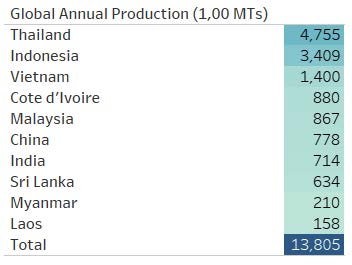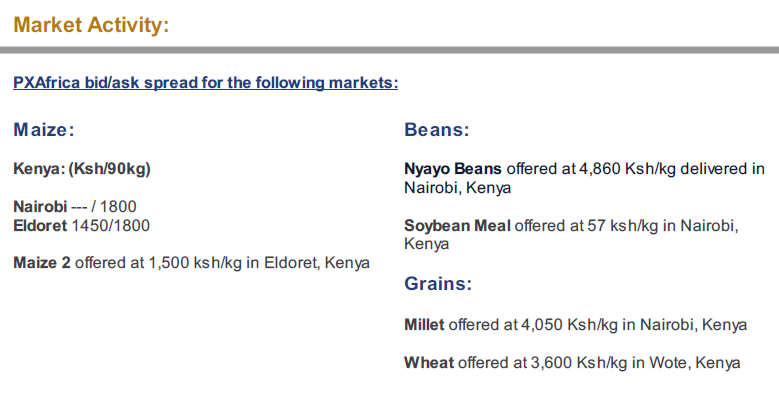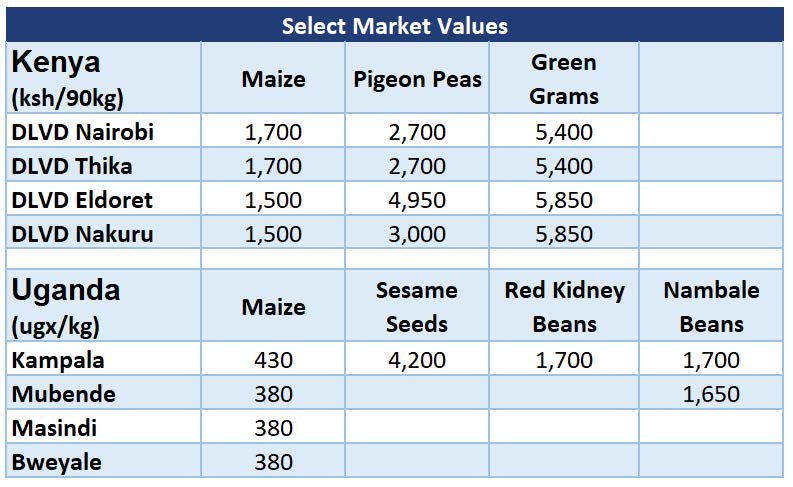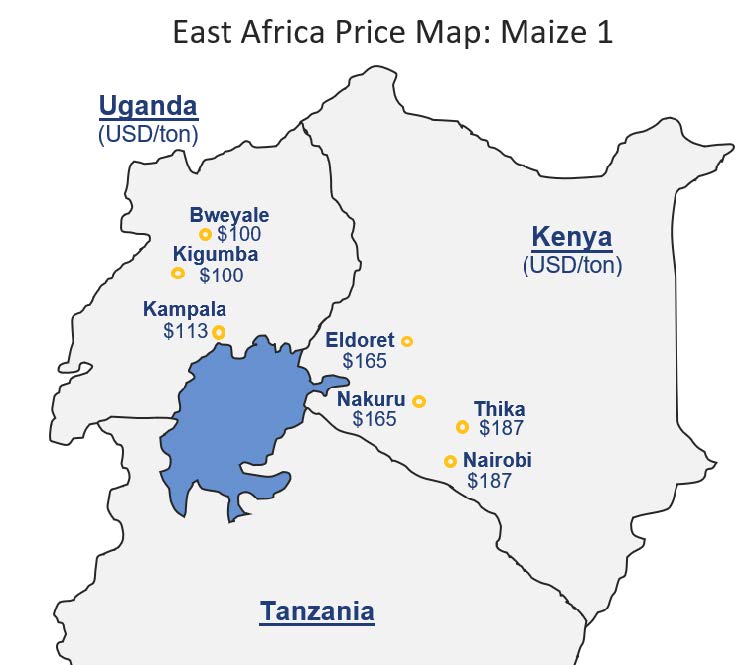Africa News
Market Update 10-11-18
Kenya:
Maize prices have been plummeting as of recently, reaching Sh800 per 90-kilogram bag as the NCPB has not allocated money to buy maize in November. It is estimated that farmers are still owed Sh2.1 billion from the NCPB from prior harvests, while maize millers in western Kenya are worried about a lack in supply of grains despite a surplus in the region.
The Senate ad hoc committee has recommended the dissolution of the National Cereals and Produce Board (NCPB) in the wake of the current maize crisis in Kenya. According to Magaret Kamar, senator representing Uasin Gishu, the board is no longer effectively serving farmers because it was engaging in activities that should be delegated to the individual counties. She went on to say, “It is likely that we will do away with the NCPB as it is constituted now. We will recommend scrapping the act under which it operates.” Although it is unknown exactly the direction the government will take in regards to the NCPB, it is certain that market dynamics will change in the coming months. We applaud any effort to take manipulation by any entity out of the markets. While intentions can certainly be called faithful, the outcome is unquestionably negative.
Rainfall is expected to be average to above-average throughout the country, while some areas in Northwestern Kenya (Lodwar, Lokichoggio and Lokituang) are forecasted to experience slightly lower than average rain fall for the month of October. The seasonal onset of rain is expected to begin between the first and third week of October for many areas in Western Kenya, Central Kenya and the Coastal Strip. Rain is expected to arrive later for the eastern parts of the country, starting during the second half of the month, while Southern Kenya is forecasted for the last week of the month, going into the first week of November. Overall, a good crop performance is expected throughout Kenya, especially in the western and central regions.
Uganda:
Maize is trading in the range of UGX 430 and UGX 450 in the Greater Kampala area as large volumes are present in the growing areas. Many farmers are preparing for the next crop which is expected between December and January and are looking at export markets to make up for losses from the past season. Beans are still available at UGX 1,700 per kilogram, although prices are expected to see downward pressure from the new crop coming into the market in November. Green grams and pigeon peas are also expected in the new crop. Production numbers and market prices will not be clear until the harvest is well under way, we will have more updates by the end of the month.
A new maize processing plant is currently under construction in the Kyenjojo district and is expected to be operational by the end of the year. The facility will feature a maize milling machine that will be able to process up to four tons per hour, two warehouses, and is expected to create approximately 10,000 jobs. Under current market dynamics, a majority of the maize produced in the Kyenjojo region is milled in Natete, some 300 miles away, and then shipped back and sold at high prices. The Kyenjojo district is the second leading producer of maize in the region and is home to about 95,000 farmers. Production in the Kyenjojo district was estimated at 10,000 metric tons of maize last season, just trailing the largest producer, the Masindi district, at 11,000 metric tons. The addition of the new processing plant has the ability to create large efficiency gains for western Uganda through having the ability to process export quality maize while lessening transportation costs.
International:
Scientists and rubber manufacturers are teaming up to figure out how to grow a crop that is the bane of homeowners’ existence: dandelions. Specifically, they’re working on the rubber dandelion native to Kazakhstan, a cousin of the common variety that is a major weed in the U.S. The main problem with the Russian dandelion is growing enough of the crop. If researchers are able to overcome this hurdle and get dandelions to grow rampant, will there be a dandelion revolution in the U.S.?
The global rubber market consists of natural rubber, made from latex present in many plants but produced only from the rubber tree cultivated in tropical climates, and synthetic rubber, derived from petroleum products, mainly styrene and butadiene.
Tire manufacturing accounts for the largest use by sector for natural rubber, and tires are made with a blend of synthetic and natural rubber. Natural rubber produces a more grippy tire, while synthetic rubber increases durability. So, bicycle tires are made with a higher percentage of natural rubber, airplane tires with a higher percentage of synthetic, and car tires in the middle.
The overwhelming majority of natural rubber is produced in Southeast Asia, mainly Malaysia, Thailand, and Indonesia, and around 50% of the total demand comes from China and Southeast Asia. Natural rubber has seen a price slump in recent years, facing oversupply and slowing production due to environmental regulations from China, and the looming concern of a trade war.
So would making rubber from dandelion latex be a worthwhile economic endeavor? Continental, one of the top global tire producers, claims to have built a tired made entirely from latex harvested from the Russian dandelion, but exact economics of production are not readily available. But under current market conditions where hub prices are below many established natural rubber producers’ cost of production, the chances of a producing a new crop economically are slim. If there are any future disruption to international trade, and specifically in the APAC region, the optionality for a reasonably economic plant on U.S. soil could play out. We’ll stick to playing covers for now.







